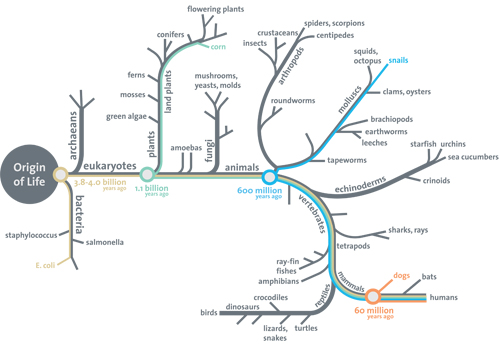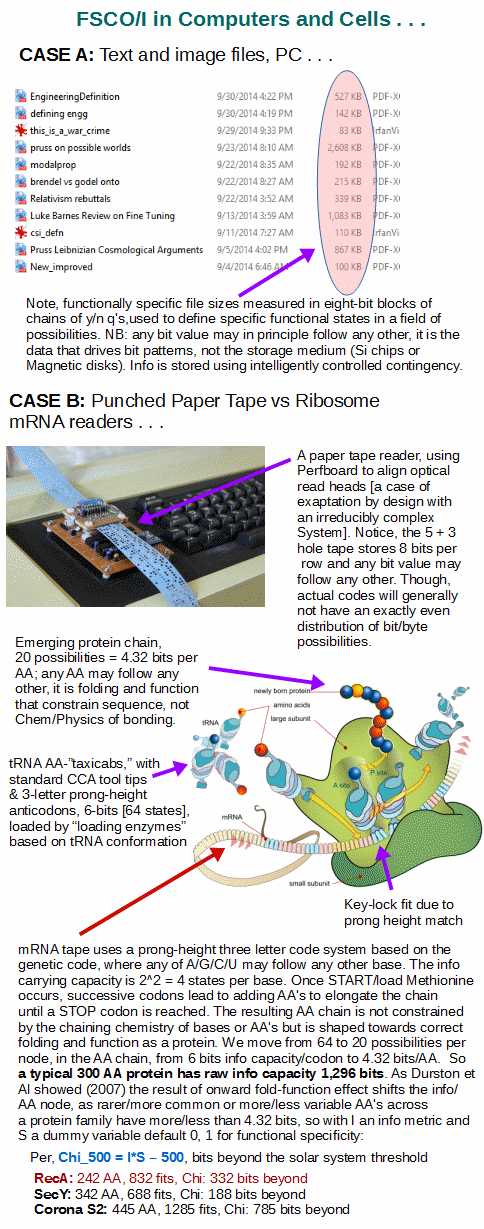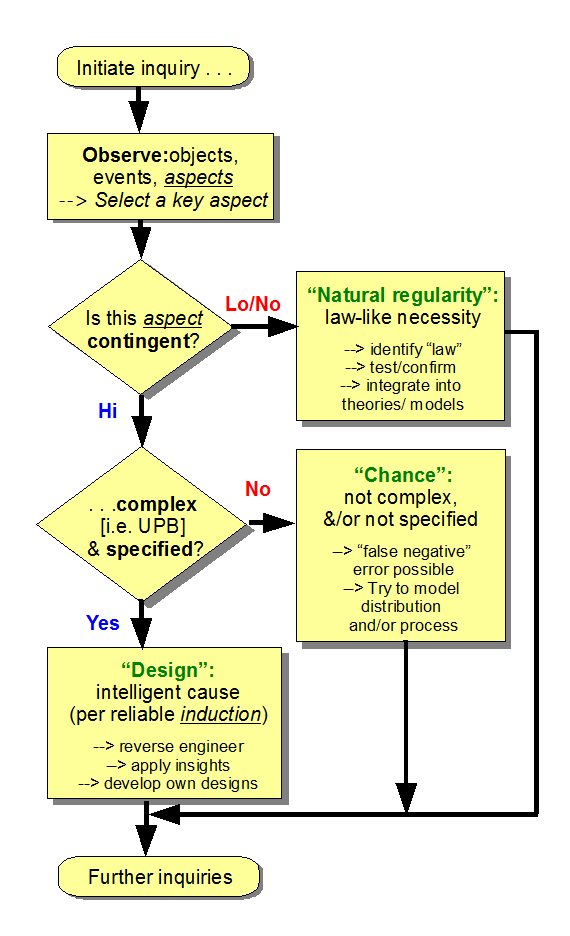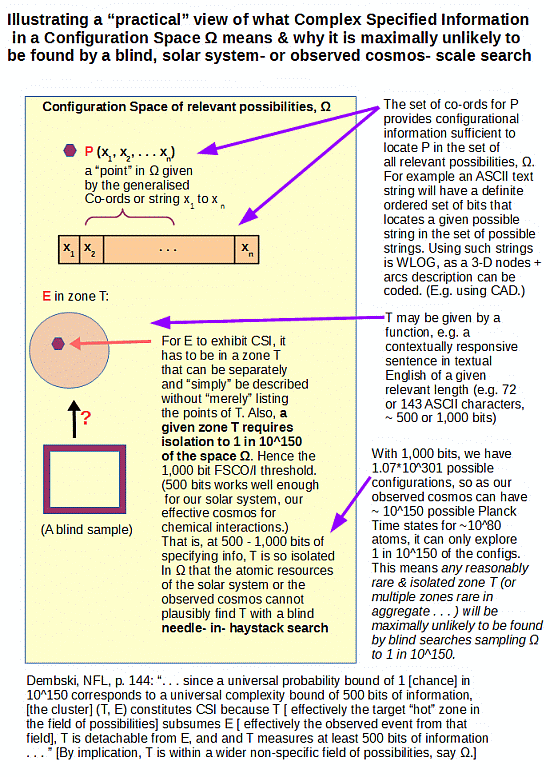Despite claims to the contrary, no.
Let’s roll the tape on a further expose of the type of rhetoric we are facing. (And no, as is now usual, KS did not respond to the point by point refutation and correction of his argument. Which, sadly, speaks volumes on the underlying mindset.)
Clipping, 221 in the HeKS suggests a way forward thread:
_____________
>>WJM, 194:
>>William J MurrayNovember 19, 2014 at 8:37 pm
Adapa said:
You made the stupid demand that I prove a negative – that random genetic variations aren’t caused by invisible pixies and that natural selection isn’t caused by 27th dimension space aliens.
I’ve only asked you to support your own assertion. If your assertion includes an unsupportable negative assumption, that’s your problem, not mine.>>
KS, retort:
>>205
keith sNovember 20, 2014 at 1:02 am
Shorter version of WJM #194:
No, no, no! You have to be unfair to ID so I can accuse you of being unfair and reject your argument!
Tough luck, William. Science works by comparing hypotheses fairly, whether you like it or not. When ID and UE are compared fairly, as I do in my argument, ID gets obliterated.
Anyone can read this comment and see that I am treating ID and UE equally.>>
Let’s roll the tape from 189, KS speaking with my comments interleaved on bullets:
KS: >> ID loses on a level playing field, and you don’t like that. You want to rig the game so that ID will win despite being an inferior hypothesis.
That is unacceptable to any honest, science-minded person.>>
a –> bare assertion, let’s see the actual case, knowing KS has long since failed the test, and is repeating falsified assertions in an attempt to make them seem solid by dominance
>>Let me try once more to explain this to you.
1. “Unguided evolution produced the ONH [objective nested hierarchies]” is a hypothesis. It might be true; it might be false. If it’s true, then unguided evolution must exist, and it must have the capabilities needed to produce the ONH. If it’s false, then either unguided evolution doesn’t exist (or was prevented from operating), or else it doesn’t have the capabilities needed to produce the ONH.>>
b –> Problem 1 as pointed out but ignored. While a general tree categorisation has been imposed on the world of life, via use of taxonomic keys, trees from general macro anatomy and those from various molecules NOTORIOUSLY diverge, mutually. Repeatedly pointed out, consistently mulishly ignored. The evidence is more consistent with a general branching tree pattern augmented by the characteristic design pattern of libraries of adaptable parts drawn upon as useful and fitted to cases. Mosaic creatures such as the Platypus are a capital example:
For, this creature is an egg-laying, milk producing, duck-billed, venomous, beaver-tailed and web-footed mammal, whose 18,527 protein-encoding genes “contain alive-and-well representatives from mammals, birds and reptiles”:
>>2. “A designer produced the ONH” is a hypothesis. It might be true; it might be false. If it’s true, then a designer must exist, and it must have the capabilities needed to produce the ONH. If it’s false, then either the designer doesn’t exist (or was prevented from operating), or else it doesn’t have the capabilities needed to produce the ONH.>>
c –> The factual base assumed is absent, there is no absolute simple tree-branching structure to explain. In addition, many products of design show a branching tree pattern with multiple inheritance (sometimes with over-rides and adaptations).
d –> In addition, there is no good reason to infer that a gradualistic process across the world of life on the implied (imagined!) vast continent of incrementally accessible configurations, will adhere to a branching tree pattern by utterly preserving originally acquired characteristics. Not to mention, the pattern of proteins in AA string config space definitively demonstrates islands of function, which is tied to the deep isolation of main body plans. These islands are rich in FSCO/I, which per trillions of examples has but one empirically observed adequate cause, intelligently directed configuration. So, on just inductive logic, we are justified in inferring that such FSCO/I is an empirically reliable sign — thus evidence — of design. Last I checked, designs come from designers, and on common sense, evidence pointing that way should be allowed to speak for itself instead of imposing selectively hyperskeptical demands that we find independent direct evidence of designers in the remote and unobservable past of origins. In short the whole argument following is a case of hyperskepticism directed at inconvenient evidence pointing to design, accompanied by the usual hypercredulous laxity towards anything that can be stretched to support a priori materialism and its fellow travellers, duly decked out in lab coats.
e –> As for a naturalistic account of OOL with adequate empirical warrant, utterly missing in action to the point that this is a pivotal reason KS et al have refused to address the challenge to produce a summary observationally warranted account of the tree of life on blind watchmaker thesis principles of chance and mechanical necessity, for two years to date.
>>3. We know that unguided evolution exists. Even the most rabid IDer/YEC will admit that antibiotic resistance can evolve, though there are people who actually believe that natural selection is a tautology, including UD President Barry Arrington, believe it or not.
4. We don’t know that the putative designer exists, so ID is already behind in the race.>>
f –> Bare assertions and strawman caricatures, contrary to serious facts. Microevolutionary trends (which we actually cannot show to be not a built-in feature for robust adaptability), in the teeth of barriers to body plan level emergence, are extrapolated unjustifiably on imposed a priori materialism or the like. As for the tautological tendencies of natural selection so called, that is a serious problem that KS wishes to wave away by implied ridicule of BA when in fact it is a seriously discussed point and it is quite hard to find a formulation of this claimed engine of evolutionary changes that is not circular.
>>5. We cannot prove that unguided evolution could accomplish every single step required to produce the ONH. That would require not only that we know every single step, which is imposible — it would also require us to know unguided evolution’s capabilities well enough to decide if each step was within its reach.
6. We cannot prove that the designer could accomplish every single step required to produce the ONH. That would require not only that we know every single step, which is imposible — it would also require us to know the designer’s capabilities well enough to decide if each step was within its reach.>>

g –> In fact this is a dodging of the basic fact that unguided chance variation [CV] and culling by differential reproductive success [CBDRS] have never been observed to produce FSCO/I, and instead by imposing a priori ideological evolutionary materialism in a lab coat or the like, gross extrapolations, hand waving and unjustified just so stories are left to stand in for the actual need to warrant per vera causa that CV + CBDRS –> IDWM –> ToL branching tree evo at body plan level is even feasible.
h –> By contrast, we know that FSCO/I is only on our experience produced by design, and that on analysis we see that deeply isolated islands of function in vast config spaces that can only be sparsely searched by blind watchmaker mechanisms, leads to a good reason to hold that such blind processes are maximally implausible as accounts of FSCO/I. So, FSCO/I should be allowed to speak on its own merits, pointing to design as the only vera causa credible known means to get to the FSCO/I.
i –> We may not know all that a designer can do, but this is already good reason to infer to design of life, and that such design would be feasible on extensions of known molecular nanotech we already practice to a limited extent. There fore, we must be willing to accept that there is evidence pointing to design and implying designers of adequate capacity.
>>7. If we assume that the ONH is out of unguided evolution’s reach, then of course unguided evolution cannot explain the ONH.
8.If we assume that the ONH is out of the designer’s reach, then of course ID cannot explain the ONH.>>
j –> Note the clever use of the term “assume” to disguise the fact that we have a known cause of FSCO/I, design, and that we have no credible cases where blind watchmaker mechanisms per our observation have caused FSCO/I. So the inference to best explanation controlled by empirical evidence is being twisted into the notion that one is merely making assumptions.
k –> That is, we see evidence of burning down inductive reasoning on evidence the heart of science, in the interests of promoting an ideology that — after 150 years of trying — persistently cannot meet the vera causa test.
>>9. If we took that attitude, then we’d have to rule out both ID and unguided evolution! That would be a ridiculous conclusion, because one of them might actually be the correct explanation.
10.Are we stuck? Of course not. Instead of assuming that they don’t work, we can assume that they do. Then we can see if one of them fits the evidence better than the other.>>
l –> Notice the dodging of the actual testimony of the evidence by a pretence of equality of “assumptions.” Nope, every tub must stand on its own bottom, as my old gramps used to say. On the cause of FSCO/I, we have a vera causa test, that before we try to explain the remote unobservable past in light of its traces in the present, we ought to prune back wild ideologically tinged or even worldviews level speculation by first showing sufficient reason for the suggested causal mechanism. That is, in the present we should see that the causal mechanism proposed has capacity to produce the effect and its traces.
m –> The critical thing to be explained in life forms is integrated, functionally specific complex interactive organisation that follows wiring diagrams and produces a coherent cluster of processes that we call cell based life, with body plans emerging form an embryological development program present in the zygote, which is a single cell. Where:
1: FSCO/I is an empirically reliable sign of design
2: Programs are a case of design and are routinely produced by designers
3: As Tour, (the molecular car man), Venter and others have shown, designers can build complex nanotech molecular scale devices using organic chemistry based techniques, and can adapt them to their purposes.
4: Cells are based on organic chemistry molecular nanotech and exhibit programming using codes and algorithms stored in D/RNA data structures. (Where, designers such as Venter et al have stored their own coded data in D/RNA in recent years.)
5: Codes are a linguistic phenomenon, something known only as a product of design, which we routinely produce. Likewise, algorithms are a manifestation of foresighted planning design, and of purposeful intelligence that shapes such designs.
6: Wiring diagram based interactive functionality based on correct parts in correct arrangement and suitably coupled together is a routine feature of design and resulting implementation.
7: Such wiring diagram patterns are evident in the world of life from the cell to the human being and at every point between.
8: That is, the precise patterns of FSCO/I seen in the world of life:
. . . have been shown to be a product of design, of intelligently and purposefully directed configuration based on skill and knowledge backed up by creative imagination. Where, we apply the longstanding per aspect, design inference explanatory filter:
9: At no point have such things beyond 500 – 1,000 bits of complexity, been shown to come about by suggested blind watchmaker mechanisms,
. . . whether the physics and chemistry of a Darwin’s pond or the like, or the systems of a living cell or those of a body plan, or even in the world of technology, especially computational technology. (In all suggested cases to the contrary, the hand of a designer is readily evident on closer examination.)
n –> That is what KS has tried to sweep under the carpet by appealing to “assumptions.”
>>11. If we take that approach and assume, temporarily and for the sake of argument alone, that unguided evolution is responsible for the diversity of life, we can see that unguided evolution predicts an objective nested hierarchy out of the trillions of possibilities.>>
o –> Begging the question under pretence of equality. First show vera causa then we can talk about credible equality.
>>12. If we take that approach and assume, temporarily and for the sake of argument alone, that the designer is responsible for the diversity of life, we can see that ID does does not predict an objective nested hierarchy out of the trillions of possibilities.>>
p –> In fact we do not have a simple nested hierarchy or its underlying branching tree pattern, as already pointed out. That already begs the question at stake — which has apparently been going on despite repeated correction, for a month here and perhaps years at TSZ etc.
q –> Such unresponsiveness to evidence and reason tied to evidence is not a good sign. Let me clip, as a caution regarding what is evidently a major problem KS and those who have enabled him o er the past several weeks need to soberly face (and links are not brought over due to a WP link budget for comments):
CLOSED-MINDED OBJECTIONISM: One far too often encounters those who are not only locked into thinking in the circle of an often demonstrably erroneous view, but are militantly and — this is the telling symptom — irrationally (i.e. fallaciously) resistant to and dismissive of correction and/or to hearing out alternative views. Thus, we may identify and descriptively define a closely associated fallacy to selective hyperskepticism; namely, the fallacy (and attitude) of the closed mind:
CLOSED-MINDEDNESS: Stubbornly irrational, question-begging resistance to correction and/or alternative views. (Cf. a typical turnabout accusation on this, here.) This fallacy manifests itself in a habitual pattern of thought, feelings and argument that is:
(a) question-beggingly committed to and/or
(b) indoctrinated into thinking in the circle of a particular view or position and/or
(c) blindly adherent to “the consensus” or vision and school of thought or paradigm of a particular set of authorities. [NB*: This last includes today’s new Magisterium: “Science.”] As a result,
(d) the victim of closed-mindedness becomes unwarrantedly (i.e. fallaciously and often abusively) resistant to new or alternative ideas, information or correction. (NB: Cf. discussions on belief, knowledge, warrant and justification here, here [an excellent introductory lecture note], here, here, here, here and here [technical].)
That is, it is not a matter of mere disagreement that is at stake here, but of (e) stubborn and objectively unjustified refusal to be corrected or to entertain or fairly discuss on the merits ideas or points of view outside of a favoured circle of thought. In extreme cases,
(f) the closed minded person who has access to power or influence may engage in the willfully deceptive (and even demonic) practice of actively suppressing the inconvenient truth that s/he knows or should know.
(By contrast, a properly educated person is open-minded but critically aware: s/he is aware of the possibility and prevalence of error, and so (i) habitually investigates and then (ii) accurately, objectively and fairly describes major alternative views, fact claims and lines of argument on a topic, (iii) comparing them on congruence to his/her real-world experience and that of others s/he knows and respects, general factual correctness, logical coherence and degree of explanatory power; thus (iv) holds a personal view that results from such a process of comparative difficulties, while (v) recognising and respecting that on major matters of debate or controversy, different people will hold different views.)
>>We have treated ID and unguided evolution exactly the same>>
r –> Not at all, as shown above. You have dodged the vital inductive reasoning responsibility to apply the vera causa test to ALL serious candidate explanations of the deep, unobservable past in order to provide a causally adequate account of its traces.
s –> By imposing the term, assumptions as though the two equally pass or fail at vera causa, you have promoted what is not a properly warranted adequate cause to treat it as though it wee just a good as a causal factor that is known to account for FSCO/I.
t –> Thus, you begged pivotal questions. >>
______________
Again, FTR, and notwithstanding non-responsiveness over the past 24 hours, discussion may continue here on in a still very active thread of discussion. END



